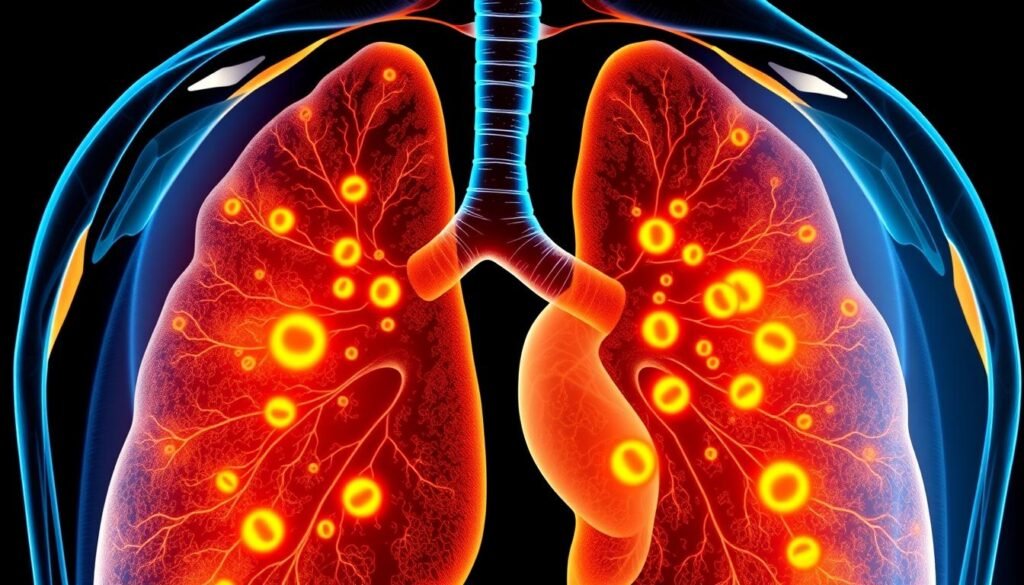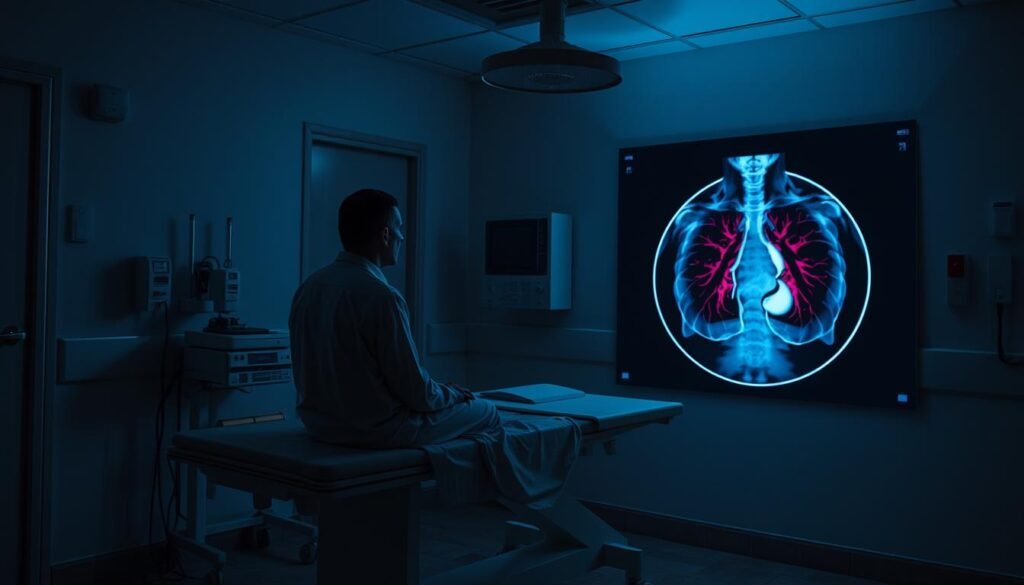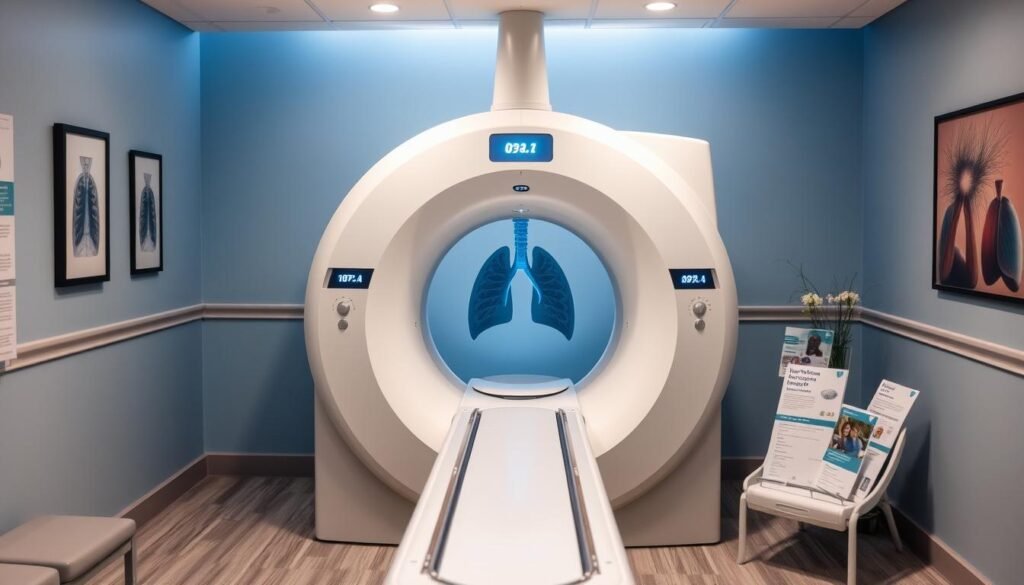Lung cancer leads to approximately 135,720 deaths yearly in the United States. It’s the top cause of cancer deaths in the country. But, catching it early can greatly improve chances of survival. By using lung cancer chest CT scans, notably low-dose computed tomography (LDCT), it’s possible to spot the disease early. Early detection means better treatment options. This guide highlights the importance of early screening, knowing your risk, and how to get diagnosed successfully.
If you smoke or used to smoke, screening could save your life. The American Cancer Society advises regular screening for 50 to 80-year-olds with a history of heavy smoking. With effective lung cancer screening, early treatment can start. This leads to higher chances of beating the disease and could save lives. We’ll cover the key points about lung cancer chest CT. You’ll learn about prep, what results mean, and where to find help if you’re at risk.
Key Takeaways
- The median age for lung cancer diagnosis is 70 years, highlighting the importance of screening sooner.
- Smoking accounts for about 90% of all lung cancer cases, with a significantly higher risk for smokers.
- Low-dose CT scans can detect early-stage lung cancer, greatly improving survival rates.
- Annual screenings for high-risk individuals are recommended to maximize early detection benefits.
- Shared decision-making with healthcare providers is crucial for determining screening necessity.
Understanding Lung Cancer: An Overview
Lung cancer is a major health issue today. It happens when cells in the lungs grow out of control. This causes many problems and usually leads to a bad outcome. In 2020, about 228,820 new cases were found, and 135,720 people died from it.
Smoking is the biggest cause of lung cancer, leading to around 90% of cases. The chance of getting it goes up as people get older. The average age for finding lung cancer is 70. There are two main types: small cell lung cancer (SCLC) and non-small cell lung cancer (NSCLC). Each type needs a different plan for finding and treating the disease.
Most times, lung cancer is found when it starts causing big problems. Chest x-rays are often the first test used. They can point to more checks if something doesn’t look right. CT scans are better at finding lung tumors than x-rays. MRI scans help see if the cancer has spread to the brain, spine, or liver. PET scans are key in finding out how far the cancer has spread.
To diagnose lung cancer, doctors might take tissue samples or drain fluid from around the lungs. These methods help decide the best treatment for each person. Knowing about the types of lung cancer, how it is diagnosed, and the numbers involved helps patients and doctors deal with lung cancer better.
The Importance of Early Detection in Lung Cancer
Early detection is key to fighting lung cancer. It can greatly improve the odds of beating the disease and increase survival rates. The American Cancer Society says lung cancer is the deadliest in the U.S. In 2016, there were 224,000 new cases and 158,000 deaths. This shows the urgent need for good screening methods.
The survival rate for lung cancer is about 18%. This is much lower than for breast cancer at 91% and colon cancer at 66%. But, detecting lung cancer early can significantly boost survival chances. Early treatment makes a huge difference.
Screenings for lung cancer, especially with low-dose CT (LDCT), are crucial. They help find the disease early and can lower death rates. A study showed a 20% reduction in lung cancer deaths with LDCT screenings. Also, 63% of cancers caught by LDCT were at stage I. This is higher than the 47.6% found through regular x-rays.
It’s important to understand why early screening matters. Many people ignore early signs, which delays diagnosis. Raising awareness about LDCT screenings helps. These are for those aged 50-80 with a history of smoking. High-risk groups are encouraged to get checked every year. This push for early screening is crucial.
| Screening Method | Mortality Rate Reduction | Stage I Detection Rate |
|---|---|---|
| Low-Dose CT (LDCT) | 20% | 63% |
| Chest X-Ray | Standard | 47.6% |
Screening early is a vital step towards better outcomes for lung cancer risk groups. Promoting LDCT screenings can lead to higher survival rates. The healthcare field must boost awareness and make screenings accessible.
Who Should Consider Lung Cancer Screening?
This part talks about who needs to think about getting checked for lung cancer. It explains how knowing if you’re at risk can help you make smart choices early on. This is key for finding the disease quickly.
Risk Factors for Lung Cancer
Some people’s choices and background put them at more risk for lung cancer. For instance, those between 50 and 80 years old who have smoked a lot over the years are more likely to get sick. This includes people who’ve smoked one pack a day for 20 years. Also, being around harmful things in the environment or having family who had lung cancer increases your risk too.
Most lung cancer deaths are among folks who smoke or used to smoke. This shows why screening is a must for these individuals.
American Cancer Society Recommendations
The American Cancer Society says adults at high risk should get yearly checks with a special CT scan. This includes people currently smoking or those who quit in the last 15 years. The United States Preventive Services Task Force agrees with this view.
Screening should stop at 81 years old, or if someone hasn’t smoked in 15 years, or if they have other health issues. Luckily, most insurance, including Medicare, pays for these screenings. Yet, any extra tests might cost more.
Lung Cancer Chest CT: What is It?
Lung cancer chest CT scans are key for spotting lung problems early. They use X-rays to make detailed pictures. This helps find issues sooner, which can make treatment more successful. Low-dose CT scans cut down on radiation, making them safer for patients.
How CT Scans Work
CT scan chest uses rotating X-ray beams and detectors for images from different angles. They track how much radiation is absorbed to create slice-like images. A computer then shows these images. Patients lie on a table that moves through the CT machine. The scan is quick, taking less than 30 seconds, and is easy on the patient.
Benefits of Low-Dose CT Scans
Low-dose CT scans are now preferred for lung cancer checks. They are both safe and effective. These scans cut radiation by up to 65% compared to older scans. They are good for regular checks without big risks. The key benefits are:
- Early detection: These scans spot small lung spots that may be cancer early on.
- Higher sensitivity: Low-dose CT finds lung cancer better than usual chest X-rays.
- Non-invasive procedure: CT scans are fast and don’t hurt, so they’re easy for patients.
Early detection with lung cancer chest CT is a major help in healthcare. Knowing how CT scans work and their low-dose options helps people make smart choices about lung checks.

Preparing for Your Lung Cancer Chest CT
The preparation for a lung cancer scan is easy and takes little effort. This CT scan doesn’t need special diets or fasting. Just make sure you’re comfortable and ready for the scan.
What to Expect Before the Scan
Before the scan, you must remove any metal items like jewelry or hairpins. Metal can mess with the imaging results. It’s also important to tell your healthcare team about any health conditions or if you could be pregnant. They might need to think of other options for you. Knowing these steps beforehand can make the experience better.
During the CT Procedure
During the scan, you’ll lie still on a table while the machine works. This part is quick, usually only 10-15 minutes. You won’t need any contrast dyes or extra meds, so it’s easy and doesn’t hurt. The machine uses a lot less radiation than older scans. This makes it safer while still checking your lung health well.
| Aspect | Details |
|---|---|
| Duration | Approximately 10-15 minutes |
| Preparation | No special diet or fasting required |
| Metal Objects | Remove all metal items before the scan |
| Radiation Exposure | Uses up to five times less radiation than traditional CT scans |
| Post-Procedure | No restrictions on normal activities or diet |
Interpreting Results from your Lung Cancer Chest CT
After a lung cancer chest CT, the journey to understanding your results begins. Radiologists look closely at the images. They mainly search for lung nodules and lesions. It’s key to know that while most lung nodules aren’t harmful, some can be early signs of lung cancer. Knowing what your results mean helps make quick and smart health decisions.
Common Findings: Lung Nodules and Lesions
Lung nodules are small masses found in the lungs through imaging tests. Not all nodules mean cancer, but it’s crucial to identify which ones might be dangerous quickly. Sometimes, the scans show other lesions in the lungs. Each has its own look and possible concern level. Radiologists work hard to figure out what these scans mean. They decide if you need more tests or a biopsy. CT scans are quite good at spotting lung cancer, with more than 90 percent accuracy.
Next Steps After Receiving Results
Once your scan has been read, talking to your healthcare team is next. If there’s something concerning, they might suggest more scans or a biopsy for clearer information. Making a plan for what comes next is crucial for your health. It’s important that you understand your health options from these chats. This helps you make the best choices for your health journey. For more on why reading CT results is key, see this resource.
The Role of Thoracic Imaging in Lung Cancer Diagnosis
Thoracic imaging is key in diagnosing and treating lung cancer. It gives doctors a close look at the lungs. This helps tell apart lung spots and figure out the cancer stage. Picking out these spots right is key to planning the best treatment.
Differentiating Between Types of Lung Lesions
Clinicians use thoracic imaging to tell different lung lesions apart. Types of lung tumors include adenocarcinoma, squamous cell carcinoma, and small cell lung cancer. Each has its own look on images. Techniques like low-dose CT scans are better at finding these lesions than normal chest X-rays.
Staging Lung Cancer Based on Imaging
Staging lung cancer depends a lot on thoracic imaging. Knowing the stage is crucial. It helps decide on surgery, meds, or comfort care. Imaging checks if lymph nodes are involved or if cancer has spread. This info shapes a treatment plan that fits the patient’s specific needs.
| Type of Lung Cancer | Common Features | Typical Size at Diagnosis |
|---|---|---|
| Adenocarcinoma | Parenchymal nodule, non-smoker propensity | Usually |
| Squamous Cell Carcinoma | Altered bronchial epithelium, cavitations | Often > 4 cm |
| Small Cell Lung Cancer | Strong association with smoking, metastatic at diagnosis | N/A (often extensively metastatic) |
| Atypical Carcinoid Tumors | Rapid growth, potential for early metastases | Typically large |
| Large Cell Carcinoma | Associated with smoking, significant lymph node enlargement | Variable, often sizable |
The Risks and Benefits of Lung Cancer Screening
Lung cancer screening is key in catching the disease early. It can lead to better outcomes for patients. By using low-dose computed tomography (LDCT), doctors have a higher chance of finding lung cancer when it’s just starting. This method comes with benefits of LDCT, like a lower chance of dying from lung cancer for those at high risk. But, we can’t ignore the risks of lung cancer screening.
Potential Risks Associated with LDCT Scans
LDCT scans are good at finding lung cancer early, but they have risks. About 250 out of every 1,000 people at high risk, but without lung cancer, get a false alarm from their scan. This means more tests, and about 2.5% of these folks will have to go through risky procedures. Most of these alerts, up to 95%, are not really cancer. False alarms can cause stress, raise healthcare costs, and bring other dangers.
Also, over 20% of cancers found this way might not have caused any problem if left alone. This situation is called overdiagnosis. It suggests that some detected cancers might not be harmful if untreated.
Comparing LDCT with Other Screening Methods
LDCT is often seen as better than standard chest X-rays for lung cancer screening. According to research, LDCT can lower the death rate from lung cancer by 16%. It can increase the chance of surviving at least five years to 52%, compared to 17% without early detection. Lung cancer is behind 28% of all cancer deaths in the U.S., making effective screening crucial.
Yet, only a small fraction of Americans who could benefit get screened. Many doctors are cautious about recommending it because of risks like false positives and overdiagnosis. But knowing the risks of lung cancer screening helps patients make better health decisions.

Making a choice about LDCT means weighing its advantages against the risks. This careful consideration guides decisions on lung cancer diagnosis and screening options.
How Often Should Screening Be Performed?
Knowing how often to get lung cancer screenings is key to finding it early. If you are at high risk, you should get a low-dose CT scan every year. Health organizations give these guidelines for a reason. It’s crucial to consider each person’s situation to decide how often they need screening.
Recommended Screening Intervals
Yearly screenings are best for those at high risk. This is mainly due to their smoking history and how old they are. The U.S. Preventive Services Task Force says adults 50 to 80 who smoked a lot should get checked every year. Regular screenings can catch lung cancer early, which could save your life. Here are the key points:
| Criteria | Details |
|---|---|
| Age Range | 50 – 80 years |
| Tobacco Smoking History | 20 pack-years (current or former smokers) |
| Screening Frequency | Annually |
Guidelines for Discontinuing Screening
When to stop screening depends on if you quit smoking and your health. Stop screening if you haven’t smoked for 15 years, the USPSTF advises. Stop too if your health gets much worse. This makes sure screenings help those who really need them. It also prevents unnecessary tests for others.
The way we screen for lung cancer is changing. It’s important to keep talking about who should get screened and when. Getting the best results means following both rules for when to start and when to stop. Patients should talk to their doctors about their screening needs. For more information, check out this study.
Resources for Lung Cancer Screening and Support
There are many resources for lung cancer to help people on their journey. Programs to stop smoking are key in lowering lung cancer risks. They offer important advice and steps for those wanting to quit. Highlighting these programs can really make a difference in people’s health.
Smoking Cessation Programs
Programs designed to help people quit smoking lower the chances of lung cancer and boost overall health. They offer personalized support, including face-to-face meetings and online help, to make it easy for everyone. With tools like the Lung Cancer Screening FAQ, they provide answers on stopping smoking and getting screened, urging people to take part.
Support Groups and Educational Materials
Help for lung cancer patients goes beyond medical treatment. Many support groups create a space of empathy and shared experiences. Organizations provide educational content, like booklets and fact sheets, to help patients understand their treatment and how to cope. A tool called the Lung Cancer Screening Journey Map shows patients the steps from checking if they’re eligible to screening and then follow-up care, for a full care journey.

Raising awareness about lung cancer is still very important, especially for women. Statistically, women are more likely to die from lung cancer than breast or ovarian cancer combined. Early detection resources can really improve survival rates.
Conclusion
Lung cancer chest CT scans are key for early lung cancer detection. This improves treatment results and survival chances. Lung cancer is behind 29% of cancer deaths in the US. So, knowing how CT scans help in screening is vital.
Low-dose CT scans can spot over 85% of lung cancers early. When found early, these cancers are easier to treat. This shows how important it is to catch lung cancer soon.
It’s also important to teach people about their risks and how screening works. A high 96% of people stick with their yearly screenings. This shows more people are learning about lung health. Following advice from trusted groups helps us fight lung cancer better.
If we educate more and keep up with screenings, we can fight lung cancer more effectively. People at risk can act early to protect their health. Getting screened for lung cancer is a big step toward better health. It really makes a difference for those at risk.